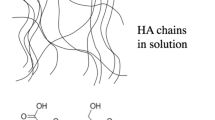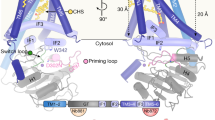Abstract
Electron microscopy shows that hyaluronan (HA) forms sheets and tube-like structures in solution. Molecular modelling by Tartu plastic space-filling atomic models revealed that hydroxymethyl and carboxylate groups of HA anti-parallel chains can be joined by H-bonds. Using these bonds, HA molecules can be modelled as sheets and tubules. These tertiary structures have three kinds of lateral contact: (1) antiparallel chains stacked by hydrophobic patches; (2) parallel chains joined by both stacking interactions and H-bonds; and (3) crossing chains joined by H-bonds and stacking interactions. Sheet and tubular structures may explain some viscoelastic and biological properties of HA.
Similar content being viewed by others
References
Scott JE (1992)FASEB J 6:2639–45.
Scott JE, Chen Y, Brass A (1992)Eur J Biochem 206:675–80.
Scott JE (1989) InThe Biology of Hyaluronan (Ciba Foundation Symposium 143), (Evered D, Whelan J, eds) Chichester: Wiley, pp. 6–20.
Scott JE, Cummings C, Greiling H, Stuhlsatz HW, Gregory JD, Damle SP (1990)Int J Biol Macromol 12:180–84.
Scott JE, Cummings C, Brass A, Chen Y (1991)Biochem J 274:699–705.
Scott JE, Heatley F, Hull WE (1984)Biochem J 220:197–205.
Sheehan JK, Gardner KH, Atkins EDT (1977)J Mol Biol 117:113–35.
Arnott S, Mitra AK, Raghunathan S (1983)J Mol Biol 169:861–72.
Mikelsaar R-H, Bruskov VI, Poltev Vi (1985) New precision space-filling atomic-molecular models. Pushchino.
Mikelsaar R-H (1986)Trends Biotechnol 4:162–63.
Gardner KH, Blackwell J (1974)Biopolymers 13:1975–2001.
Woodcock C, Sarko A (1980)Macromolecules 13:1183–87.
Mikelsaar R-H, Kusnetsova N (1992) InLigno-cellulosics: Science, Technology, Development and Use (Kennedy JF, Phillips GO, Williams PA, eds.) New York, London, Toronto, Sydney, Tokyo, Singapore: Ellis Horwood Ltd, pp. 479–83.
Gardner KH, Blackwell J (1975)Biopolymers 14:1581–95.
Minke R, Blackwell J (1978)J Mol Biol 120:167–81.
Author information
Authors and Affiliations
Rights and permissions
About this article
Cite this article
Mikelsaar, RH., Scott, J.E. Molecular modelling of secondary and tertiary structures of hyaluronan, compared with electron microscopy and NMR data. Possible sheets and tubular structures in aqueous solution. Glycoconjugate J 11, 65–71 (1994). https://doi.org/10.1007/BF00731145
Received:
Revised:
Issue Date:
DOI: https://doi.org/10.1007/BF00731145




